Real road-tripping: Heartland loop
A month and a half ago, I posted a look at a hypothetical road-trip vacation. It was, I said, a replacement for going on an actual vacation, which costs money I would prefer not to spend.
Just kidding!
With a week of vacation to burn and both friends and family calling my name from around the country, I packed up my car, filled up the tank and set out to take a big loop around the American Heartland.
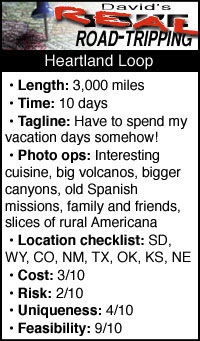 My destination was southern Texas, but I’d spend a lot more time going to and from the Lone Star State than actually staying there. At the end of the road in San Antonio were my aunt, uncle, and sole cousin not currently away at college, as well as other friends just up the road in Austin.
My destination was southern Texas, but I’d spend a lot more time going to and from the Lone Star State than actually staying there. At the end of the road in San Antonio were my aunt, uncle, and sole cousin not currently away at college, as well as other friends just up the road in Austin.
Along the way, I would shape my trip for convenience, to meet up with friends, to find good (and preferably free) places to sleep at night, to see interesting sights and take fantastic photos. Overall, while nothing on the trip stood head-and-shoulders above anything else, it was full of lots of nice, simple pleasures and didn’t end up costing me too much money.
Unlike my previous venture into deepest, darkest Canada, this was all familiar territory. I’ve visited every state on the trip before. So no long preamble about various things I’ve learned. Instead, straight into the trip!
Day 1: Rapid City, SD, to Denver, CO (395 miles, 7 hours)
After putting in a morning at the office, I hopped in the car shortly after noon for the first leg of my journey, to the Denver metropolis where a friend’s air mattress awaited. The roads were largely deserted (though I still went largely the speed limit, not wanting to blemish my trip with a ticket). Cutting through the Black Hills, I pulled over for a photo and originally had plans of getting photos of every “Welcome to [STATE]” sign along the way.
 This ultimately would not end up happening, as much of my travel took place on much more important highways than this. Those welcome signs were well situated to be seen by those driving by, but usually lacked good pull-off spots like Wyoming so generously provided.
This ultimately would not end up happening, as much of my travel took place on much more important highways than this. Those welcome signs were well situated to be seen by those driving by, but usually lacked good pull-off spots like Wyoming so generously provided.
Other than this sign, Wyoming didn’t offer much of interest other than as a waystation. I had a brief chat with another South Dakotan (from East River) at a Cheyenne gas station in which we tried to identify where we were from by our license plate prefixes, and made my way into Denver in early evening.
After meeting up with my friend there, we went out to dinner, sampled a few bars, and crashed.
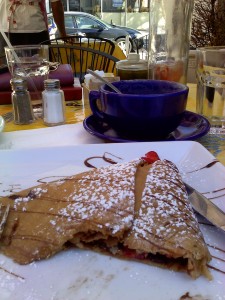
Right: A crêpe sucrée and hot chocolate at “Crêpes N Crêpes” in Denver.
Day 2: Rest in Denver.
It was a low key day. In the morning I met up with another Denver friend for perhaps the most delicious meal of the entire journey: Crêpes!
The rest of the day included a mix of downtime (watching my Chicago Bears annihilate my friend’s Atlanta Falcons, playing some computer games ourselves) and activity (biking around the area and tossing a frisbee around). At night I had Vietnamese pho — something not readily available in Rapid City — before crashing for an early start.
Day 3: Denver to Amarillo, TX (434 miles, 7.5 hours)
All the Colorado natives I talked to during my stay in Denver encouraged me to visit the Colorado Sand Dunes. I was assured it was fantastic, picturesque and absolutely worth my visit. Unfortunately, they were an hour and a half off the interstate and would turn an eight-hour day (in which I lose an hour from crossing back into Central Time) into something closer to 11.
Instead, I settled for a natural attraction I didn’t even know existed until I saw a sign for it in the tiny New Mexican town of Capulin: the Capulin Volcano National Monument. A cinder cone volcano that’s either extinct (if you believe Wikipedia) or dormant (if you believe the signs at the park), it rises steeply above the otherwise flat and arid plains of northeast New Mexico. For $5 I drove close to the top and then hiked a very steep mile around the edge.
The volcano somehow failed to erupt while I was there.
Here’s what the mountain looked like from atop the cone’s lip, looking down on the visitor center parking lot where my blue sedan is the third car from the left:

And here’s the view from the top of the volcano, looking towards the near-ghost town of Folsom — down to 75 people from its peak of over 1,000, and the site of one of the major archaeological finds of the 20th Century:

Supposedly one can see Colorado off in that direction, although I’m unsure if this photo actually reaches over the border.

After visiting the volcano — well worth my $5 and the hour or so I spent taking it in — I proceeded a little down the road and found a place serving lunch. As someone who’s lived a significant portion of his life in Iowa and almost all his life in the Midwest, I was highly amused to sit down in a diner in the town of Des Moines, NM, population 177.
Finally it was on into the destination state of this road trip: Texas. If there’s one thing everyone knows about Texas, it’s that it’s big. Damn big. I covered a mere 120 miles of Texas this day.
My destination for the evening was Amarillo. The Amarillo metro area has a population of over 230,000, but that didn’t stop the city from drawing almost universal derision from everyone to whom I said I was spending the night there. As someone who’s lived in and covered some pretty desolate places in South Dakota, the place didn’t seem that bad. Besides, I wasn’t looking to move there. I just wanted a place to spend the night, and this happened to be halfway between Denver and San Antonio.
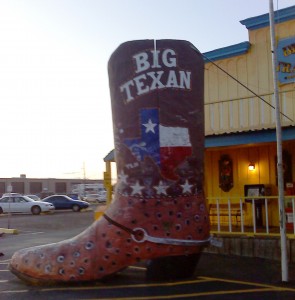
It certainly had its own unique charms. I figured that if I was in West Texas, there was only one option for dinner: steak. My first option, a highly reviewed supper club, turned out to be closed, so I went to the more touristy Big Texan Steak Ranch (see boot at left).
Inside, a cowboy band roamed around performing country-western classics for tips. (I passed.) The crowd was much more polyglot than one would perhaps expect in Amarillo. The table in front of me were Australians who sang along boisterously with the band, while a group I passed on my way in appeared to be Czech.
I ordered a decent (if overpriced) steak and a local beer, trying to avoid thinking on the incongruity between my all-American meal and my principal dinner activity: reading a thick scholarly tome about the Thirty Years War. What can I say? I’m a bookish fellow. Plus, I was just getting to the good parts (AKA, page 200 of 1,000).
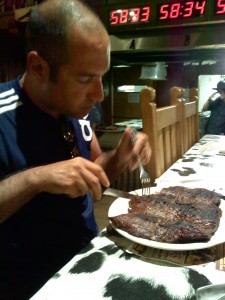 But I didn’t keep my nose in the book the whole meal. Partway through, staff at the Steak Ranch got on the loudspeakers to announce a spectacle: three men (soon to be four) would be taking on the restaurant’s “72 Ounce Challenge” — eat a four-and-a-half pound steak within 60 minutes, and it’s free. (If not, the emcee said, they would at least be well-fed, if considerably lighter in the wallet.)
But I didn’t keep my nose in the book the whole meal. Partway through, staff at the Steak Ranch got on the loudspeakers to announce a spectacle: three men (soon to be four) would be taking on the restaurant’s “72 Ounce Challenge” — eat a four-and-a-half pound steak within 60 minutes, and it’s free. (If not, the emcee said, they would at least be well-fed, if considerably lighter in the wallet.)
I didn’t stick around, alas, to see if any of the four gentleman overcame the challenge — nor whether they survived the challenge or passed away from food poisoning from “some other steakhouse.” It was back to a surprisingly affordable (or surprisingly nice, depending on your perspective) Days Inn for an early bed time, since it was going to be an early start the next day.
First, though, I took the time to get a photo of another Amarillo landmark. Traveling across the country, one sees plenty of churches and plenty of gas stations, but rarely does one see the two combined in quite the manner of the Jesus Christ Is Lord Travel Center just off I-40 in Amarillo:
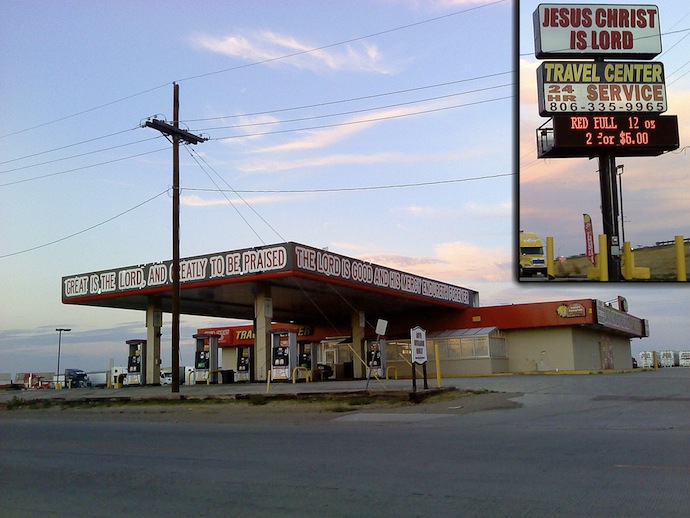
Day 4: Amarillo, TX, to San Antonio, TX (511 miles, 8.5 hours)
I was on the road before 8 a.m. (or 7 a.m., per my Mountain Time-ing body clock) in order to catch what I expected to be the most impressive sight of the trip early on: Palo Duro Canyon.
This geological formation holds the dubious distinction of being America’s second-largest canyon, and it doesn’t hold a candle to the Grand. But it looks spectacular and, I’m sure, puts #3 to shame.
I had actually learned about this canyon while reading about the Comanches and the wars against them in the mid-19th Century. One of the key battles in the eventual American victory over the Comanche natives was the Battle of Palo Duro Canyon. Author S.C. Gwynne evocatively describes the setting:
> > ...in all of the southern plains, there was no better place to hide. In the general vicinity of present-day Amarillo, the dead-flat Llano Estacado gave way to the rocky buttes and muscular upheavals of the caprock, where the elevation fell as much as a thousand feet. Into this giant escarpment the four major forks of the Red River had cut deep, torturous canyons, creating some of the most dramatic landscapes in the American West. The spectacular Palo Duro Canyon, carved out over the geologic aeons by the Prairie Dog Town Fork of the Red River, was a thousand feet deep, one hundred twenty miles long, between a half-mile and twenty miles wide, and crossed by innumerable breaks, washes, arroyos and side canyons. ("Empire of the Summer Moon," p. 275) > >
With this spectacle just a few minutes off my route to San Antonio, how could I say no?
It did not disappoint.

Above is the view of Palo Duro Canyon from the rim. Below, a closeup of the banded rock formation in the canyon’s walls:
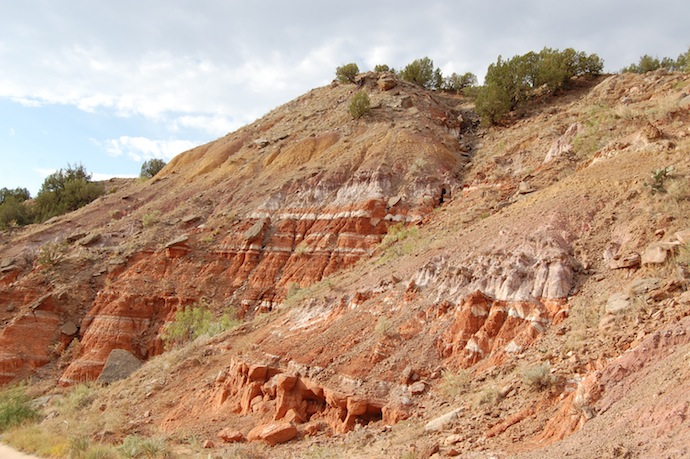
And another angle of the bottom from about halfway down:

Unfortunately, my half-hour stay didn’t permit me to fully explore the canyon. Of particular interest would have been some of the canyon’s hiking trails. I’ll just have to reserve that for a future visit where I can set aside the day.
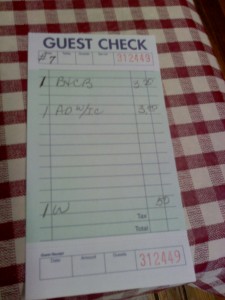 I was on the road again for a long day’s drive through West Texas. This part of Texas is currently suffering through among the worst droughts ever, and local residents have taken prudent — if shocking — measures to survive. Case in point is this receipt from the small-town diner I ate at in Post, TX, where you can see I paid $3.50 for beans and cornbread (not terribly good), $3 for an apple dumpling with ice cream (not bad) — and 50 cents for a glass of water.
I was on the road again for a long day’s drive through West Texas. This part of Texas is currently suffering through among the worst droughts ever, and local residents have taken prudent — if shocking — measures to survive. Case in point is this receipt from the small-town diner I ate at in Post, TX, where you can see I paid $3.50 for beans and cornbread (not terribly good), $3 for an apple dumpling with ice cream (not bad) — and 50 cents for a glass of water.
This, of course, upended my normal frugal dining habits. My rule of thumb is to generally drink only water at meals, since restaurants usually considerably inflate the costs of drinks above what they pay. Water serves the practical purpose of drinks just as much as anything, and in normal places, it’s free. So I save myself $2-$4 a meal by skipping the pop or juice or whatever. My water-quaffing self would not do so well in West Texas.
Other than this brief encounter with the laws of supply and demand, however, this day’s drive was largely uneventful. I made it into the Texas Hill Country in late afternoon and was suitably impressed by the sudden rise out of the central Texas plains. Meeting up with my aunt, I had dinner, hung out a bit with my cousin, and made what to my introverted self is an unusually large amount of polite conversation (but which I’m sure to other people seems remarkably taciturn).
Day 5: San Antonio, TX, to Austin, TX, and back (160 miles, 3 hours)
After a lazy morning and lunch with my aunt and her friend at a very nice Mexican place, I hopped in my car to drive up I-35 to Austin, the capital of Texas and the capital of Texas Weird. Waiting for friends to get off work, I toured the Texas Capitol building. I had to pass through metal detactors to get in, but other than that and its predictably larger size it wasn’t that different from South Dakota’s humble Capitol.
The House and Senate chambers were both nicely appointed, a bit more spacious than South Dakota’s, with ample room for visitors. The Legislature was not in session, so I was able to freely roam around and snap pictures of places like the Senate:
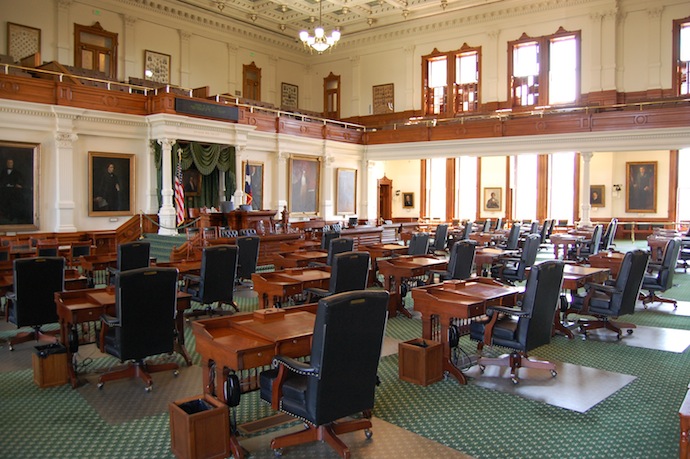
Portraits of former governors, a few of whom went on to bigger and better things:
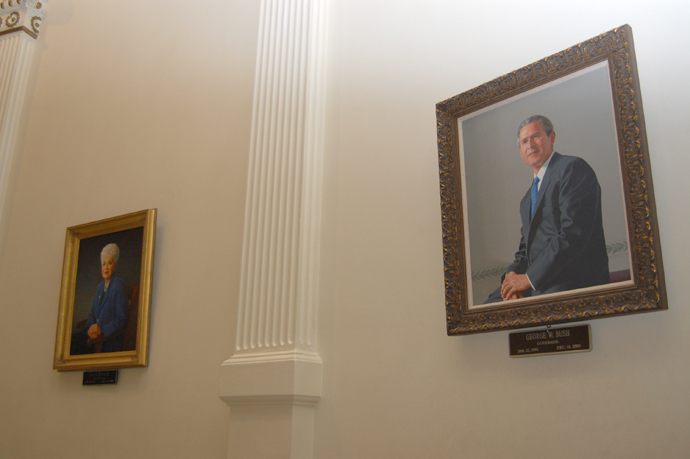
And the building’s tree-lined approach:
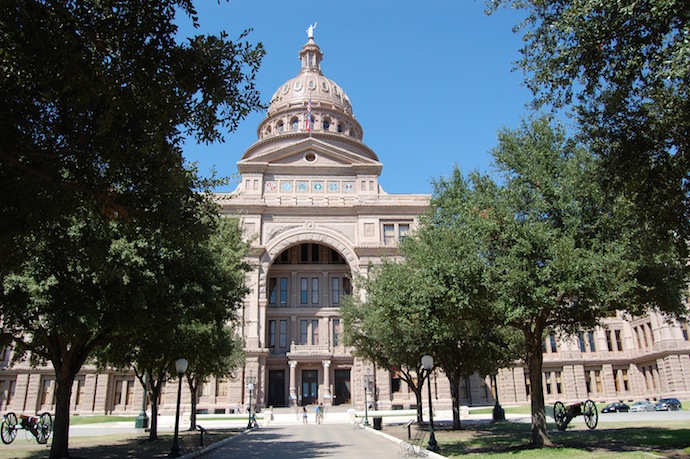
After taking in this center of government, I headed through the downtown to the Bob Bullock Texas State History museum. This is Texas’s monument to itself, and they make that clear from the entrance:
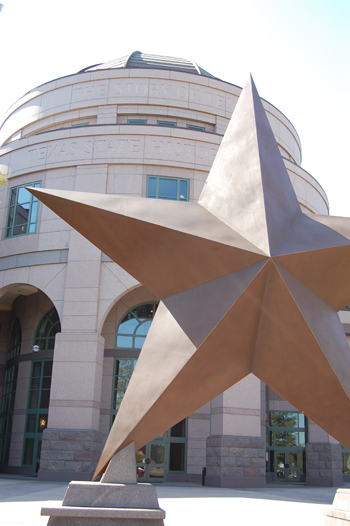 There were no cameras allowed inside, and I didn’t feel like being surreptitious, so I didn’t get to document some of the surprisingly good exhibits inside on everything from Texas’s native settlements before the arrival of whites, to the colonial days and the Texas Revolution, through the Civil War, the Dust Bowl and the oil boom. To some of my Texas friends’ shock I skipped the exhibit on Texas high school football, but my high school had a terrible football team (and didn’t have lights so played in the daytime, anyway) so I have little romance for the Friday night lights.
There were no cameras allowed inside, and I didn’t feel like being surreptitious, so I didn’t get to document some of the surprisingly good exhibits inside on everything from Texas’s native settlements before the arrival of whites, to the colonial days and the Texas Revolution, through the Civil War, the Dust Bowl and the oil boom. To some of my Texas friends’ shock I skipped the exhibit on Texas high school football, but my high school had a terrible football team (and didn’t have lights so played in the daytime, anyway) so I have little romance for the Friday night lights.
Of particular note in the museum was a video I let the guy at the desk talk me into paying for. An overview of Texas history, it used a variety of practical special effects to emphasize its images. For example, there were different layers of screens, used to create the illusion of depth. When the Galveston hurricane was discussed, light mist rained down on us. A mention of locusts brought a surprisingly lifelike puff of air on the nape of the neck. And most potentially frightening of all, talk about Texas rattlesnakes triggered the sudden inflation of a band running through the seat cushions, as if there were a serpent in the upholstery. Overall it was amusing, if perhaps not something I’d recommend to jumpier friends.
Nearby the history museum I met up with some friends for drinks at an odd little bar that offered a cheese platter to go with our beer. One of my greatest disappointments of the trip was my failure to take a photo of the cheese tray before leaving.
Then it was on to Austin’s Congress Street Bridge, under whose eaves tens of thousands of bats roost. At sunset every night, they all fly out in great numbers to hunt. My photos of this cool little phenomenon didn’t come out terribly great — a zoom lens would have been nice to have. On the up side, the warnings I had received that the bats were prone to depositing presents on spectators beneath them proved to be baseless.
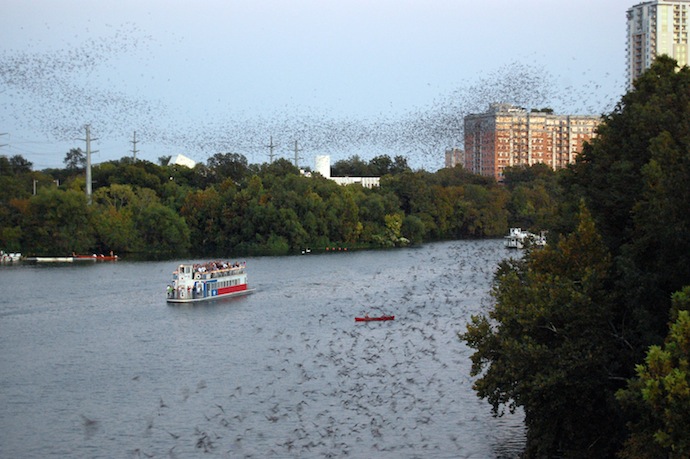
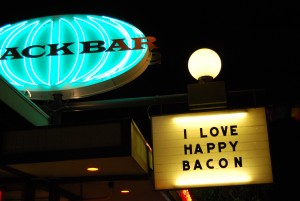 We then walked through the city, taking in a number of odd sights (right) on our way to a nifty burger joint, Hopdoddy Burger Bar. It was packed solid on this weekday night, but with only a moderate wait we were in for some delicious (if sloppy) cheeseburgers. I myself had the “Magic Shroom” burger of beef, cheese, mushrooms and basil.
We then walked through the city, taking in a number of odd sights (right) on our way to a nifty burger joint, Hopdoddy Burger Bar. It was packed solid on this weekday night, but with only a moderate wait we were in for some delicious (if sloppy) cheeseburgers. I myself had the “Magic Shroom” burger of beef, cheese, mushrooms and basil.
This late dinner devoured, I wandered back to the car and then made the night drive back to San Antonio. Despite warnings from all parties about how bad Texas traffic could be, I never ran into serious slowdowns at any point in the Lone Star State.
In fact, of all Texas’s particular charms, I think its roads have to rate near the top. The state’s rural highways usually have more lanes than a route with similar traffic would have up in South Dakota — and going from two to four lanes on a long, desolate rural highway makes a big difference. Moreover the urban superhighway system features the marvelous innovation of frontage roads — minor highways in and of themselves running alongside the freeways, with regular exits onto and off of the frontage roads on a regular basis. It takes up a great deal more space and perhaps lends itself to sprawl, but it’s a delight to drive on.
Day 6: Chilling in San Antonio
No driving for me this day. I set out with my aunt to take a look at San Antonio’s chief historical relics: the old Spanish missions. The most famous of these, the Alamo, I had seen before. It’s not too impressive. Instead we went to the Mission San José y San Miguel de Aguayo. Three hundred years ago it was miles and miles from the Alamo, part of a chain of Spanish missions along the San Antonio River. Today it’s in the middle of the country’s seventh-largest city.
The missions today are partially ruined, but even as shadows of what they once were are still impressive:
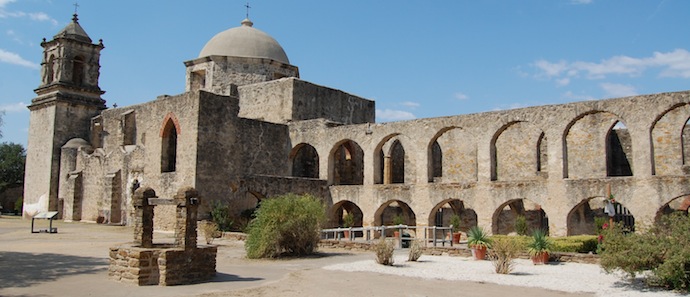
And:
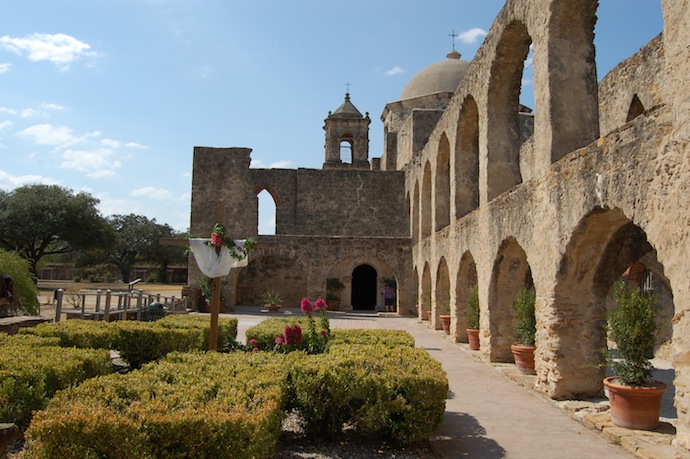
And the decorated doors of the mission’s still-functioning church, where a park employee filled the eaves with the sounds of a traditional flute.
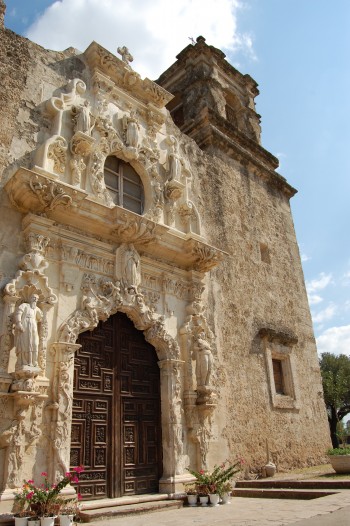 Also at the mission was a restored grain mill, built on the location of the mission’s original mill. (The foundation and millrace, I believe, remain from the original, while the building and the grindstone and such are later restorations.) A helpful volunteer explained all about the milling process, including how the mission’s mill was only used for wheat, and not corn. The latter, the preferred food of the natives living on the mission, was seen as uncivilized, so the natives were forced to grind their own corn using a mortar and pestle. (It wasn’t practical to split the mill between the two grains, due to the necessity to clean the millstones to avoid cross-contamination.)
Also at the mission was a restored grain mill, built on the location of the mission’s original mill. (The foundation and millrace, I believe, remain from the original, while the building and the grindstone and such are later restorations.) A helpful volunteer explained all about the milling process, including how the mission’s mill was only used for wheat, and not corn. The latter, the preferred food of the natives living on the mission, was seen as uncivilized, so the natives were forced to grind their own corn using a mortar and pestle. (It wasn’t practical to split the mill between the two grains, due to the necessity to clean the millstones to avoid cross-contamination.)
It’s always impressive how effective seemingly primitive technology like early modern mills can be at performing vital tasks.
We returned from the mission in time for dinner. From there I went out with my uncle to see a movie at the Alamo Drafthouse cinema — a very nice movie theater whose principal quirk is that there’s full meal and drink service during the picture. But the audience-friendly features go beyond the unobtrusive black-clad waiters. The screen is large, the sound excellent. There aren’t any annoying pre-show advertisements, only trailers. The seats themselves are huge and comfortable, with plenty of legroom.
The movie itself, the disease thriller “Contagion,” was good as well. I hope to review it here in the not-too-distant future. (Update: the review is here.)
Day 7: Fun in and around San Antonio
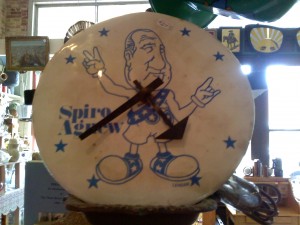 After bandying around a number of different ideas, my aunt and I got into her car for a visit to some of the small towns around the Texas Hill County — small communities, originally settled by German immigrants, now with a tourism- and craft-based economy. My meager budget wasn’t enough to afford any of the artwork or antiques we saw — even a fantastic Spiro T. Agnew wall clock would have set me back $25, too much for a novelty.
After bandying around a number of different ideas, my aunt and I got into her car for a visit to some of the small towns around the Texas Hill County — small communities, originally settled by German immigrants, now with a tourism- and craft-based economy. My meager budget wasn’t enough to afford any of the artwork or antiques we saw — even a fantastic Spiro T. Agnew wall clock would have set me back $25, too much for a novelty.
 Lunch at the Gristmill River Restaurant and Bar was highly disappointing. The view looking down onto the Guadalupe River was nice, but despite the town and restaurant’s German theme, there was almost no German food available. The “Best Wurst” I had wasn’t even German but rather Polish sausage, and it was terrible, tasteless and bland. My aunt’s salad ended up being basically just a pile of leaves, and the wait staff weren’t familiar with her request for gluten-free food and brought the salad with croutons.
Lunch at the Gristmill River Restaurant and Bar was highly disappointing. The view looking down onto the Guadalupe River was nice, but despite the town and restaurant’s German theme, there was almost no German food available. The “Best Wurst” I had wasn’t even German but rather Polish sausage, and it was terrible, tasteless and bland. My aunt’s salad ended up being basically just a pile of leaves, and the wait staff weren’t familiar with her request for gluten-free food and brought the salad with croutons.
More impressive was the Wimberley Glassworks, where I got to watch a live demonstration of artisans making glass vases and other items. It was quite cool to see them blow and shape the molten glass into something recognizable in just a few minutes. Then I saw how much the store was charging for that 20 minutes of work and wondered if perhaps I had gotten into the wrong profession.

Returning home to San Antonio, I played some nice ultimate frisbee with a group of my cousin’s high school friends, where I managed to hold my own without actually taking advantage of my advanced height and age.
Then, after dinner, the whole family went down to the San Antonio Riverwalk:
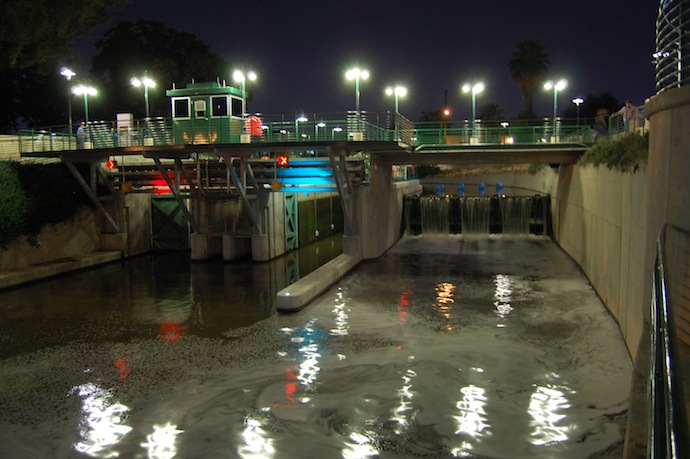
And that was that. We returned home, I slept, packed up my things, and got on the road by 10 a.m. after a nice breakfast.
Day 8: San Antonio, TX, to Oklahoma City, OK (466 miles, 7.5 hours)
 This was the day I got up close and personal with I-35, shooting straight up through Texas to central Oklahoma. I had a spare but good lunch of bread and a summer sausage at a roadside picnic spot. In Oklahoma City, I meandered around the city’s surprisingly nice downtown district, called Bricktown, and had a nice meal of pasta, stuffed mushrooms and red wine. This I managed to finish and pay for just as the wind picked up and lightning started flashing outside. A minute after I made it back to my car, the skies opened up with a classic Great Plains thunderstorm.
This was the day I got up close and personal with I-35, shooting straight up through Texas to central Oklahoma. I had a spare but good lunch of bread and a summer sausage at a roadside picnic spot. In Oklahoma City, I meandered around the city’s surprisingly nice downtown district, called Bricktown, and had a nice meal of pasta, stuffed mushrooms and red wine. This I managed to finish and pay for just as the wind picked up and lightning started flashing outside. A minute after I made it back to my car, the skies opened up with a classic Great Plains thunderstorm.
My hotel that night, a Super 8, was pretty seedy, but I made it out without losing any belongings or gaining any parasites.
Day 9: Oklahoma City, OK to Omaha, NE (457 miles, 8 hours)
Driving conditions today were mixed. Part of it was spent along the Kansas Turnpike, which is obnoxious to pay for but not too expensive and has some nice rest stop facilities in the medians to allow drivers access to services without leaving the tollway. Then I shifted to back highways for the final shot up to Omaha, and was making excellent time until I ran into a traffic accident half an hour outside of the city. I had pulled over minutes before that to check the map, and wonder if I would have gotten through the intersection before the accident without that stop — or been a witness to the incident?
Regardless, I myself made it through to Omaha unscathed, where I met up with a friend. After consulting the restaurant listings, we went to a highly regarded Indian restaurant whose excellent food belies the unbelievably seedy exterior:

The food there, while excellent, was also far too spicy for my very mild tastes. Had I not ordered some naan bread I’m not sure I’d have been able to finish, even after asking the waiter for a mildly spiced dish.
Then, after playing (and losing) a few rounds of video games, I retired for my last night of sleep away from home on this road trip.
Day 10: Omaha, NE, to Rapid City, SD (502 miles, nine hours)
The home stretch — and one of the most interesting stretches of this whole trip.
I avoided the interstates and instead took back highways through rural Nebraska on my way back to South Dakota. This most direct route had another advantage: among the towns it passed through was tiny Tilden, population 1,078 — the town where I lived for the first three years of my life.
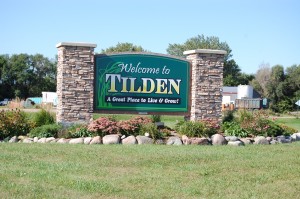 Since moving away at the age of three, I have no recollection of ever returning.
Since moving away at the age of three, I have no recollection of ever returning.
Seen again through adult eyes, Tilden was a curious mix of seedy and nice. Much of the main highway through town was greyish and run-down, catering to passing truckers and farmers with heavy machinery. But drive a block away from the highway and the town was verdant and peaceful.
My chief goal was to find my infant home, whose address I had procured before setting out. Tilden being a small place, this was not very difficult:
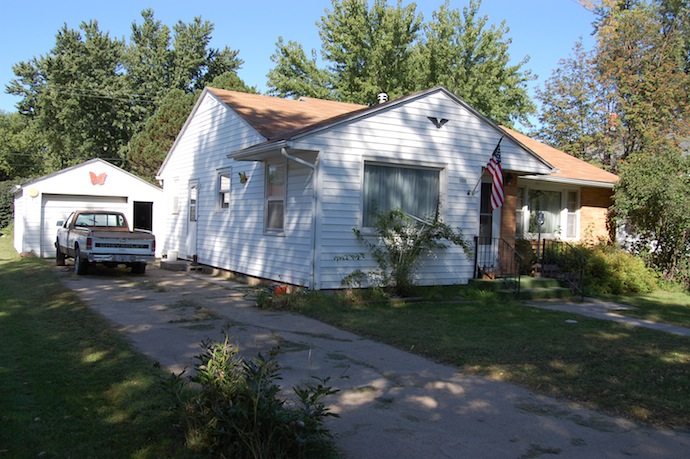
I also found the church where my father had been minister at the time:
And, finally, I filled up my tank with gas at the quaintest little full-service downtown gas station imaginable:

The old man working the pump was very friendly, though he had no real memory of my parents living there.
It was neat to see Tilden, as a glimpse into what might have been. It would not have been the worst place in the world to grow up, but I don’t regret that my parents did move and raise me in more urban environments. I like the broader array of options available in the cities and suburbs, even as my time working in South Dakota has driven home the appeal the rural lifestyle can have as well.
Finally, on the tenth day of travel, I returned home right around five in the afternoon. I’d completed the trip with no tickets, no breakdowns, no other emergencies, and returned home to my apartment in good working order. I had fun on the road, didn’t spend too much money, and didn’t have anything terrible happen. What more can you ask for out of a good road trip?
My approximate route:
